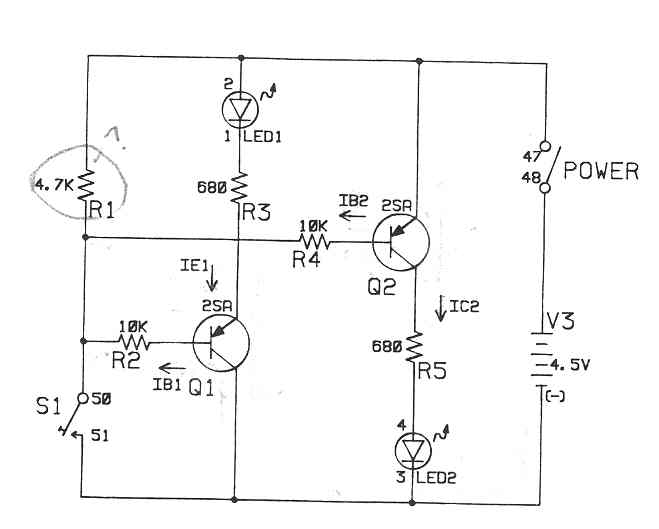Circuit explanation
[noparse][[/noparse]Please refer to the attached .jpg file]
What's the purpose of the R1 resistor in the attached circuit (a simple demo of transistor switches). Is it just to limit the overall current when the POWER and S1 switches are both thrown at the same time? Or is it doing something else that I'm just not seeing?
Thanks!
▔▔▔▔▔▔▔▔▔▔▔▔▔▔▔▔▔▔▔▔▔▔▔▔
M. Kibat
Bloomington, MN
kibatme@visi.com
What's the purpose of the R1 resistor in the attached circuit (a simple demo of transistor switches). Is it just to limit the overall current when the POWER and S1 switches are both thrown at the same time? Or is it doing something else that I'm just not seeing?
Thanks!
▔▔▔▔▔▔▔▔▔▔▔▔▔▔▔▔▔▔▔▔▔▔▔▔
M. Kibat
Bloomington, MN
kibatme@visi.com



Comments
▔▔▔▔▔▔▔▔▔▔▔▔▔▔▔▔▔▔▔▔▔▔▔▔
·1+1=10
After power is applied, with S1 open, R1 biases both transistors OFF. Closing S1 turns both transistors ON, and the LEDs light. Without R1, with S1 open, the transistors would be in an indeterminate state, and chaos would reign! (just kiddin'!)
Happy holidays!
kenjj
The circuit will work if you delete the resistor R1, but it is better for elevated temperatures to have it present.
The small leakge current from both transistor collectors to their respective bases has a "drain-away" path through this resistor, and also it facilitates the quick dissipation of charge in the base-emitter junctions, thus causing it to switch faster.
For the penny that it costs, it is just a better way to do things.
Cheers,
Peter (pjv)
▔▔▔▔▔▔▔▔▔▔▔▔▔▔▔▔▔▔▔▔▔▔▔▔
·1+1=10
Bean.
▔▔▔▔▔▔▔▔▔▔▔▔▔▔▔▔▔▔▔▔▔▔▔▔
"SX-Video·Module" Now available from Parallax for only $28.95
http://www.parallax.com/detail.asp?product_id=30012
"SX-Video OSD module" Now available from Parallax for only·$49.95
http://www.parallax.com/detail.asp?product_id=30015
Product web site: www.sxvm.com
Forget about the past, plan for the future, and live for today.
·
▔▔▔▔▔▔▔▔▔▔▔▔▔▔▔▔▔▔▔▔▔▔▔▔
·1+1=10
As Bean said, what my post referred to was in omitting the resistor; NOT replacing it with a piece of wire.
Cheers,
Peter (pjv)
▔▔▔▔▔▔▔▔▔▔▔▔▔▔▔▔▔▔▔▔▔▔▔▔
·1+1=10
Just kidding
▔▔▔▔▔▔▔▔▔▔▔▔▔▔▔▔▔▔▔▔▔▔▔▔
Mike
·
▔▔▔▔▔▔▔▔▔▔▔▔▔▔▔▔▔▔▔▔▔▔▔▔
M. Kibat
Bloomington, MN
kibatme@visi.com